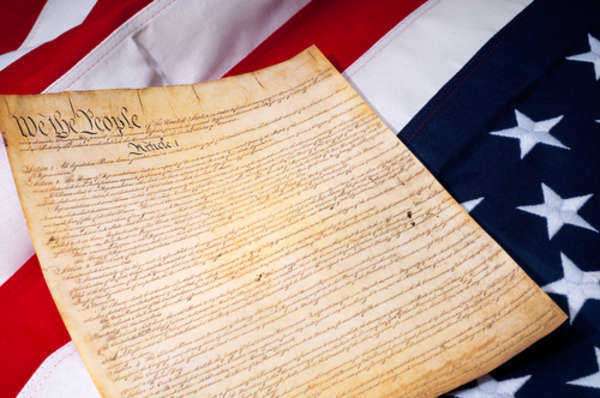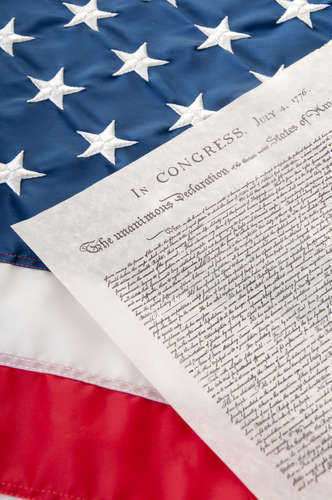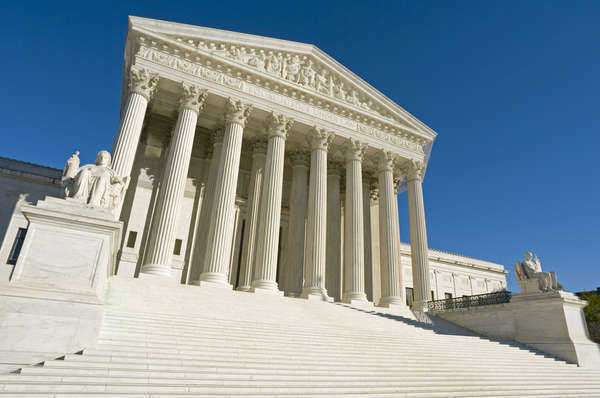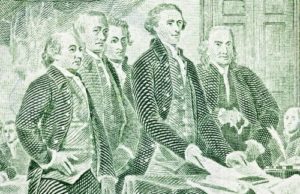
10TH AMENDMENT – OVERVIEW, CASES AND DECISIONS TIMELINE
The Tenth Amendment of the United States Constitution reads: “The powers not delegated to the United States by the Constitution, nor prohibited by it to the States, are reserved to the States respectively or to the people.” This amendment has played a significant role in clarifying the relationship between the federal government and the states in the United States. In this article, we will discuss the major court cases that relate to the Tenth Amendment and how they have affected federalism in the United States.
1789 – The Judiciary Act of 1789
The Judiciary Act of 1789 established the federal court system and was signed into law by President George Washington. The Act helped set the stage for the notion that the federal government would have shared sovereignty with the states since it established both federal and state courts that would interpret and enforce federal law.
1832 – Worcester v. Georgia
Worcester v. Georgia of 1832 was a landmark Supreme Court case that focused on the question of whether individual states had the right to regulate activities within their borders involving Native American tribes. In the ruling, the court held that, while states had the power to regulate within their borders, they could not control the relationship between the federal government and Native American tribes. This decision established the principle of federal preemption and federal supremacy over state laws in matters of federal interest, a principle that would later be reinforced by the general interpretation of the Tenth Amendment.
1869 – Texas v. White
In the Texas v. White case of 1869, the U.S. Supreme Court noted that the federal government was not created by the states but rather the people. The case questioned the legal authority of secession and the validity of Confederate bonds. The court ultimately found that Texas had not validly seceded from the United States and, therefore, remained subject to the U.S. Constitution. This ruling left no doubt that the federal government had supreme authority in the relationship with state governments.
1908 – Hammer v. Dagenhart
The case of Hammer v. Dagenhart in 1908 challenged Congress’s ability to regulate child labor. The Supreme Court held that the federal government had no authority to regulate factories and industries that sold solely within a state, citing the Tenth Amendment’s protection of state sovereignty and its protection against federal overreach. The decision was later challenged with the Fair Labor Standards Act of 1938, which outlawed child labor across the United States.
1934 – National League of Cities v. Usery
National League of Cities v. Usery in 1976 examined the scope of the power of Congress to regulate state employees’ wages and hours under the auspices of the Fair Labor Standards Act. The Supreme Court deemed the law unconstitutional, noting that it represented an undue burden on state sovereignty and was inconsistent with the Tenth Amendment. However, this decision was later reversed in the aftermath of the Garcia v. San Antonio Metropolitan Transit Authority in 1985.
1992 – New York v. United States
New York v. United States in 1992 related to the low-level radioactive waste program of the federal government, where the government attempted to mandate that states enact state-level regulations on waste disposal. The Supreme Court found that elements of the mandate violated the Tenth Amendment and the general principles of federalism. The decision affirmed that the Tenth Amendment protected states’ rights and autonomy within the federal system.
1997 – Printz v. United States
Printz v. United States questioned whether federal law could bind state officials to carry out federal background checks under the Brady Handgun Violence Prevention Act. The Court held that Congress could not require local officials to implement federal law in that capacity. The decision confirmed that the Tenth Amendment allowed states to retain power for themselves or their agents, which cannot be exercised by the federal government.
2010 – National Federation of Independent Business v. Sebelius
One of the most significant cases regarding the Tenth Amendment was the National Federation of Independent Business v. Sebelius in 2010. This case questioned the legality of the Affordable Care Act’s individual mandate, which compelled citizens to purchase health insurance. A plurality of the court found that Congress had overreached its powers by compelling the private sector to purchase insurance but chose to keep up the law, provided that states could opt-out of the Medicaid expansion provided for by federal law.
2020 – Department of Homeland Security v. New York
The most recent Tenth Amendment case is the Department of Homeland Security v. New York of 2020, which questions the legality of the Trump administration’s attempt to rescind the Deferred Action for Childhood Arrivals (DACA) program. The United States Supreme Court ultimately found against the Trump administration, finding that the procedure by which the program was rescinded violated principles of administrative law, and undermined the primacy of the Tenth Amendment.
Conclusion
The Tenth Amendment protects the rights of states to self-govern and informs how political power is distributed in the United States. The Tenth Amendment has played an important role across a wide range of legal challenges pertaining to State vs. Federal power such as Worcester v. Georgia, Hammer v. Dagenhart, National League of Cities v. Usery, New York v. United States, Printz v. United States, National Federation of Independent Business v. Sebelius, and Department of Homeland Security v. New York. These landmark cases highlight the principles of federalism and balancing the power between the federal government and the states. As the United States continues to evolve and challenges arise regarding state vs. federal power, the Tenth Amendment will remain an essential element of the Constitution.
The 10th Amendment: Preserving State Power in a Federal System
Introduction
The United States Constitution, often hailed as a masterpiece of political thought and governance, established a delicate balance of power between the federal government and individual states. At the heart of this intricate framework lies the 10th Amendment, a concise yet powerful declaration of states’ rights. The 10th Amendment has played a pivotal role in American history, shaping the nation’s development and the ongoing debate over federalism. In this 2000-word article, we will delve deep into the 10th Amendment, exploring its origins, historical significance, contemporary relevance, and the ongoing discussions surrounding it.
The Text of the 10th Amendment
The 10th Amendment to the United States Constitution reads:
“The powers not delegated to the United States by the Constitution, nor prohibited by it to the States, are reserved to the States respectively, or to the people.”
On the surface, this amendment may appear straightforward, but its implications are profound. It encapsulates the essence of federalism, defining the boundaries of federal and state authority within the American system of government. To understand its significance fully, we must delve into its historical context and the Founding Fathers’ intentions.
Historical Context: The Birth of a Nation
The United States Constitution was drafted during the Constitutional Convention of 1787 in Philadelphia, Pennsylvania. The framers of the Constitution were confronted with the daunting task of designing a government that could unite thirteen diverse and sometimes conflicting states under a single federal authority while preserving their individual sovereignty.
The Constitution aimed to strike a balance between a strong central government capable of addressing national concerns and a system that would prevent tyranny, protect individual liberties, and allow state governments to retain substantial autonomy. It was in this context that the 10th Amendment emerged as a vital component of the Bill of Rights.
The Bill of Rights and the 10th Amendment
The Bill of Rights, comprising the first ten amendments to the Constitution, was introduced by James Madison in the First Congress. These amendments were intended to address concerns raised during the ratification process of the Constitution and ensure that individual liberties and state powers were protected. Among these amendments, the 10th Amendment stood out as a clear statement of the Founding Fathers’ commitment to limiting federal power.
Madison’s draft of the 10th Amendment underwent several revisions before reaching its final form. The inclusion of the phrase “or to the people” was a crucial addition, emphasizing that not only are powers reserved to the states but also to the individuals themselves, reinforcing the principles of a government by the people, for the people.
The Essence of Federalism
Federalism is a core principle in American governance, and the 10th Amendment embodies its essence. Federalism divides authority between a central government and regional governments, with each level retaining certain powers. It is a system that acknowledges the diversity and uniqueness of each state while also recognizing the necessity of a unified national government to address common concerns.
The 10th Amendment, with its focus on “powers not delegated to the United States,” underscores the idea that the federal government only possesses those powers explicitly granted to it by the Constitution. All other powers remain with the states or the people. This principle of limited federal authority is fundamental to the American system of government.
Interpreting the 10th Amendment: Federalism in Practice
The 10th Amendment has been the subject of significant debate and interpretation throughout American history. Different interpretations have shaped the relationship between the federal government and state governments and have had a profound impact on various aspects of public policy and governance.
- Dual Federalism: In the early years of the United States, a doctrine known as “dual federalism” prevailed. This perspective held that the federal government and state governments operated in separate spheres with clearly defined powers. This interpretation of the 10th Amendment limited federal intervention in state affairs and allowed states significant autonomy in matters such as commerce, education, and criminal law.
- Cooperative Federalism: Over time, the interpretation of federalism evolved, giving rise to the concept of “cooperative federalism.” In this approach, the federal and state governments collaborate on various policy areas. While this may appear to diminish states’ rights, it reflects the increasing complexity of modern governance and the interdependence of federal and state authorities in areas like transportation, healthcare, and environmental regulation.
- New Federalism: In response to perceived federal overreach during the mid-20th century, the concept of “new federalism” emerged. Advocates of new federalism called for a return to a more decentralized system, where states would have greater control over their affairs and receive block grants from the federal government to fund programs as they saw fit.
- Judicial Interpretation: The courts, particularly the Supreme Court, have played a crucial role in interpreting the 10th Amendment. Landmark cases like Gibbons v. Ogden (1824), United States v. Lopez (1995), and National Federation of Independent Business v. Sebelius (2012) have shaped the boundaries of federal and state authority. These decisions have clarified the scope of federal power, addressing issues such as commerce, gun control, and healthcare.
Contemporary Relevance: The 10th Amendment Today
The 10th Amendment remains a cornerstone of American federalism in the 21st century. It continues to influence debates on a wide range of policy issues, reflecting the ongoing tension between state and federal authority.
- Healthcare and the Affordable Care Act (ACA): The ACA, also known as Obamacare, sparked a heated debate over federalism. Critics argued that the federal government overstepped its bounds by mandating individual healthcare coverage. The Supreme Court’s decision in NFIB v. Sebelius upheld the law’s constitutionality but also clarified that Congress cannot coerce states into expanding Medicaid.
- Marijuana Legalization: The issue of marijuana legalization has brought the 10th Amendment to the forefront once again. Some states have legalized marijuana for both medicinal and recreational use, even though it remains illegal at the federal level. This conflict highlights the tension between state and federal drug laws, with states asserting their right to regulate substances within their borders.
- Immigration Policy: Immigration policy is another area where the 10th Amendment is relevant. States like Arizona have sought to enact their own immigration laws, arguing that the federal government has failed to address the issue adequately. These state-level actions have led to legal challenges and debates over the scope of federal authority in immigration matters.
- COVID-19 Pandemic Response: The COVID-19 pandemic raised questions about the balance between federal and state authority in public health emergencies. States took various approaches to managing the crisis, from mask mandates to business closures, revealing differing interpretations of the 10th Amendment’s role in such situations.
- Gun Control: The debate over gun control often centers on the tension between state and federal laws. While some states have enacted stricter gun control measures, others have relaxed regulations. Advocates for stricter federal gun control laws argue that a uniform approach is needed to address the issue effectively.
Critiques and Challenges
While the 10th Amendment has its proponents who champion the preservation of states’ rights, it is not without its critics and challenges.
- Overlapping Jurisdiction: In an increasingly interconnected world, some argue that strict adherence to states’ rights can result in inefficiency and confusion when addressing complex, cross-border issues like environmental protection or transportation infrastructure
.
- Inequality and Civil Rights: Critics argue that states’ rights have historically been used to justify discrimination and the infringement of civil rights. The 10th Amendment has been invoked in debates over issues like segregation and same-sex marriage, with opponents of states’ rights emphasizing the need for federal intervention to protect equal rights.
- Practical Limitations: The 10th Amendment does not provide clear guidance on how to resolve conflicts between federal and state laws. This lack of clarity can lead to legal battles and protracted disputes that hinder effective governance.
- Evolving Society: Some argue that the 10th Amendment was designed for a different era and that the challenges and complexities of the modern world require a more flexible approach to governance that accommodates the interdependence of states.
Conclusion: Balancing the Tension
The 10th Amendment remains a pivotal component of American federalism, embodying the tension between state and federal authority that has defined the nation’s governance since its inception. It reflects the enduring debate over the appropriate balance of power in a diverse and dynamic society.
As the United States continues to grapple with complex and evolving challenges, the interpretation and application of the 10th Amendment will remain a subject of intense scrutiny and debate. Striking the right balance between states’ rights and federal authority is an ongoing challenge, one that reflects the enduring struggle to uphold the principles of liberty, equality, and effective governance upon which the nation was founded. The 10th Amendment, with its concise yet profound language, will continue to be a guiding star in this ever-evolving journey of American democracy.
The 10th Amendment: Reserving Powers to the States and the People
Introduction
Within the framework of the United States Constitution, the 10th Amendment holds a pivotal role in the distribution of power between the federal government and the states. As the final entry in the Bill of Rights, this amendment emphasizes the principle of federalism and the concept that powers not expressly delegated to the federal government are reserved for the states or the people. This article explores the nuances of the 10th Amendment and its relationship to the legal landscapes of all 50 states, illuminating the intricate balance between central authority and state autonomy.
The 10th Amendment’s Essence
The 10th Amendment, often referred to as the “states’ rights” amendment, reinforces the division of powers enshrined in the Constitution. It underscores the idea that the federal government’s authority is limited to the specific powers explicitly granted to it, leaving the residual powers to the states or the people. This amendment embodies the delicate equilibrium between federal supremacy and state sovereignty.
Unpacking the 10th Amendment Across the States
In this section, we’ll embark on a journey through the legal terrain of each state, exploring how the 10th Amendment shapes their individual identities within the American legal mosaic. From Alabama to Wyoming, we’ll examine the states’ interpretations, actions, and court decisions that reflect the complex interplay between federal power and state autonomy.
Alabama: State Sovereignty and Autonomy
In Alabama, the 10th Amendment echoes the state’s commitment to preserving its sovereignty and autonomy. The state’s legal framework acknowledges that powers not granted to the federal government inherently belong to the states. Alabama’s courts invoke the 10th Amendment to delineate the boundaries of federal authority and protect the state’s interests.
Alaska: State Identity and Self-Governance
In Alaska, the 10th Amendment resonates with the state’s emphasis on asserting its identity and right to self-governance. The state’s legal framework recognizes that the Constitution’s enumeration of federal powers does not negate the existence of state authority. Alaska’s courts use the 10th Amendment to safeguard the state’s role in governing its affairs.
Arizona: Balance of Power and Federal Supremacy
In Arizona, the 10th Amendment contributes to the ongoing dialogue about the balance of power and federal supremacy. The state’s legal framework acknowledges the principle that powers not granted to the federal government remain vested in the states. Arizona’s courts employ the 10th Amendment to maintain the equilibrium between central authority and state sovereignty.
Arkansas: State Autonomy and Federal Limitations
In Arkansas, the 10th Amendment’s emphasis on state autonomy aligns with the state’s recognition of federal limitations. The state’s legal framework acknowledges that the Constitution’s silence on certain matters indicates a reserved role for the states. Arkansas’s courts invoke the 10th Amendment to affirm the state’s capacity to govern within its jurisdiction.
California: State Innovation and Federal Boundaries
In California, the 10th Amendment intersects with the state’s propensity for innovation and the boundaries set by federal authority. The state’s legal framework recognizes the importance of preserving the states’ roles in shaping policy within their borders. California’s courts use the 10th Amendment to navigate the intricate relationship between state-driven initiatives and federal constraints.
Colorado: Local Governance and State Authority
In Colorado, the 10th Amendment resonates with the state’s commitment to local governance and asserting its authority within the federal framework. The state’s legal framework acknowledges that the Constitution’s enumeration of federal powers does not negate the state’s inherent authority. Colorado’s courts invoke the 10th Amendment to ensure the state’s capacity to legislate for its citizens.
Connecticut: State Rights and Federal Constraints
In Connecticut, the 10th Amendment’s focus on state rights aligns with the state’s recognition of federal constraints. The state’s legal framework acknowledges the principle that powers not expressly granted to the federal government are retained by the states. Connecticut’s courts use the 10th Amendment to affirm the state’s role in shaping its laws and policies.
Delaware: State Sovereignty and Shared Governance
In Delaware, the 10th Amendment’s emphasis on state sovereignty aligns with the state’s commitment to shared governance. The state’s legal framework recognizes that the federal government’s authority is limited to enumerated powers. Delaware’s courts invoke the 10th Amendment to safeguard the state’s role in coexisting with federal authority.
Florida: Federalism and State Autonomy
In Florida, the 10th Amendment underscores the significance of federalism and the state’s autonomy. The state’s legal framework acknowledges the principle that powers not delegated to the federal government are reserved for the states. Florida’s courts use the 10th Amendment to strike a balance between federal mandates and state prerogatives.
Georgia: State Identity and Limited Federal Powers
In Georgia, the 10th Amendment resonates with the state’s commitment to preserving its identity and limiting federal powers. The state’s legal framework recognizes the importance of maintaining a distinct state character. Georgia’s courts use the 10th Amendment to delineate the scope of federal authority while safeguarding the state’s unique interests.
Hawaii: Local Governance and State Autonomy
In Hawaii, the 10th Amendment intersects with the state’s emphasis on local governance and asserting its autonomy. The state’s legal framework recognizes the value of decisions made at the state level. Hawaii’s courts use the 10th Amendment to navigate the balance between federal mandates and the state’s authority to address local needs.
Idaho: State Rights and Federal Parameters
In Idaho, the 10th Amendment’s focus on state rights aligns with the state’s acknowledgment of federal parameters. The state’s legal framework recognizes that powers not granted to the federal government are retained by the states. Idaho’s courts use the 10th Amendment to affirm the state’s role in shaping its legal landscape.
Illinois: Federalism and Shared Governance
In Illinois, the 10th Amendment underscores the principles of federalism and shared governance. The state’s legal framework recognizes that the federal government’s authority is limited to specific powers. Illinois’s courts use the 10th Amendment to safeguard the state’s role in coexisting with federal authority.
Indiana: State Identity and Federal Constraints
In Indiana, the 10th Amendment resonates with the state’s commitment to preserving its identity and recognizing federal constraints. The state’s legal framework acknowledges that the Constitution’s enumeration of federal powers does not negate state authority. Indiana’s courts use the 10th Amendment to delineate the boundaries of federal jurisdiction.
Iowa: Local Governance and State Prerogatives
In Iowa, the 10th Amendment intersects with the state’s emphasis on local governance and asserting its prerogatives. The state’s legal framework recognizes the significance of decisions made at the state level. Iowa’s courts use the 10th Amendment to navigate the interplay between federal mandates and the state’s authority to address local needs.
Kansas: State Rights and Federal Balance
In Kansas, the 10th Amendment’s focus on state rights aligns with the state’s recognition of the need for federal balance. The state’s legal framework recognizes that the Constitution’s enumeration of federal powers does not preclude state authority. Kansas’s courts use the 10th Amendment to ensure a harmonious relationship between federal authority and state sovereignty.
Kentucky: State Autonomy and Shared Governance
In Kentucky, the 10th Amendment resonates with the state’s commitment to state autonomy and shared governance. The state’s legal framework acknowledges the principle that powers not granted to the federal government remain vested in the states. Kentucky’s courts use the 10th Amendment to uphold the state’s role in coexisting with federal authority.
Louisiana: Federalism and State Prerogatives
In Louisiana, the 10th Amendment underscores the principles of federalism and state prerogatives. The state’s legal framework recognizes that the federal government’s authority is limited by the Constitution. Louisiana’s courts use the 10th Amendment to navigate the balance between federal mandates and the state’s authority to address local needs.
Maine: State Rights and Federal Mandates
In Maine, the 10th Amendment’s focus on state rights aligns with the state’s recognition of federal mandates. The state’s legal framework acknowledges that the Constitution’s enumeration of federal powers does not negate state authority. Maine’s courts use the 10th Amendment to delineate the boundaries of federal jurisdiction.
Maryland: State Autonomy and Federal Boundaries
In Maryland, the 10th Amendment resonates with the state’s commitment to state autonomy and recognizing federal boundaries. The state’s legal framework acknowledges the principle that powers not expressly granted to the federal government are retained by the states. Maryland’s courts use the 10th Amendment to navigate the complex relationship between federal authority and state sovereignty.
Massachusetts: Federalism and State Identity
In Massachusetts, the 10th Amendment underscores the principles of federalism and state identity. The state’s legal framework recognizes that the federal government’s authority is limited by the Constitution. Massachusetts’s courts use the 10th Amendment to uphold the state’s role in coexisting with federal authority.
Michigan: State Autonomy and Shared Governance
In Michigan, the 10th Amendment resonates with the state’s commitment to state autonomy and shared governance. The state’s legal framework acknowledges that the Constitution’s enumeration of federal powers does not preclude state authority. Michigan’s courts use the 10th Amendment to ensure a harmonious relationship between federal authority and state sovereignty.
Minnesota: State Rights and Federal Balance
In Minnesota, the 10th Amendment’s focus on state rights aligns with the state’s recognition of the need for federal balance. The state’s legal framework recognizes that the federal government’s authority is limited by the Constitution. Minnesota’s courts use the 10th Amendment to navigate the balance between federal mandates and the state’s authority to address local needs.
Mississippi: Federalism and State Prerogatives
In Mississippi, the 10th Amendment underscores the principles of federalism and state prerogatives. The state’s legal framework recognizes that the Constitution’s enumeration of federal powers does not negate state authority. Mississippi’s courts use the 10th Amendment to delineate the boundaries of federal jurisdiction.
Missouri: State Autonomy and Federal Mandates
In Missouri, the 10th Amendment resonates with the state’s commitment to state autonomy and recognizing federal mandates. The state’s legal framework acknowledges that the Constitution’s enumeration of federal powers does not preclude state authority. Missouri’s courts use the 10th Amendment to navigate the complex relationship between federal authority and state sovereignty.
Montana: State Rights and Shared Governance
In Montana, the 10th Amendment’s focus on state rights aligns with the state’s recognition of the importance of shared governance. The state’s legal framework recognizes that the federal government’s authority is limited to specific powers. Montana’s courts use the 10th Amendment to uphold the state’s role in coexisting with federal authority.
Nebraska: State Autonomy and Federal Boundaries
In Nebraska, the 10th Amendment resonates with the state’s commitment to state autonomy and recognizing federal boundaries. The state’s legal framework acknowledges the principle that powers not expressly granted to the federal government are retained by the states. Nebraska’s courts use the 10th Amendment to navigate the intricate relationship between federal authority and state sovereignty.
Nevada: Federalism and State Identity
In Nevada, the 10th Amendment underscores the principles of federalism and state identity. The state’s legal framework recognizes that the federal government’s authority is limited to specific powers. Nevada’s courts use the 10th Amendment to uphold the state’s role in coexisting with federal authority.
New Hampshire: State Autonomy and Shared Governance
In New Hampshire, the 10th Amendment resonates with the state’s commitment to state autonomy and shared governance. The state’s legal framework acknowledges that the Constitution’s enumeration of federal powers does not preclude state authority. New Hampshire’s courts use the 10th Amendment to navigate the complex relationship between federal authority and state sovereignty.
New Jersey: State Rights and Federal Mandates
In New Jersey, the 10th Amendment’s focus on state rights aligns with the state’s recognition of recognizing federal mandates. The state’s legal framework acknowledges that the Constitution’s enumeration of federal powers does not negate state authority. New Jersey’s courts use the 10th Amendment to delineate the boundaries of federal jurisdiction.
New Mexico: Federalism and State Prerogatives
In New Mexico, the 10th Amendment underscores the principles of federalism and state prerogatives. The state’s legal framework recognizes that the federal government’s authority is limited to specific powers. New Mexico’s courts use the 10th Amendment to uphold the state’s role in coexisting with federal authority.
New York: State Autonomy and Federal Boundaries
In New York, the 10th Amendment resonates with the state’s commitment to state autonomy and recognizing federal boundaries. The state’s legal framework acknowledges the principle that powers not expressly granted to the federal government are retained by the states. New York’s courts use the 10th Amendment to navigate the intricate relationship between federal authority and state sovereignty.
North Carolina: Federalism and State Identity
In North Carolina, the 10th Amendment underscores the principles of federalism and state identity. The state’s legal framework recognizes that the federal government’s authority is limited to specific powers. North Carolina’s courts use the 10th Amendment to uphold the state’s role in coexisting with federal authority.
North Dakota: State Autonomy and Shared Governance
In North Dakota, the 10th Amendment resonates with the state’s commitment to state autonomy and shared governance. The state’s legal framework acknowledges that the Constitution’s enumeration of federal powers does not preclude state authority. North Dakota’s courts use the 10th Amendment to navigate the complex relationship between federal authority and state sovereignty.
Ohio: State Rights and Federal Mandates
In Ohio, the 10th Amendment’s focus on state rights aligns with the state’s recognition of recognizing federal mandates. The state’s legal framework acknowledges that the Constitution’s enumeration of federal powers does not negate state authority. Ohio’s courts use the 10th Amendment to delineate the boundaries of federal jurisdiction.
Oklahoma: Federalism and State Prerogatives
In Oklahoma, the 10th Amendment underscores the principles of federalism and state prerogatives. The state’s legal framework recognizes that the federal government’s authority is limited to specific powers. Oklahoma’s courts use the 10th Amendment to uphold the state’s role in coexisting with federal authority.
Oregon: State Autonomy and Federal Boundaries
In Oregon, the 10th Amendment resonates with the state’s commitment to state autonomy and recognizing federal boundaries. The state’s legal framework acknowledges the principle that powers not expressly granted to the federal government are retained by the states. Oregon’s courts use the 10th Amendment to navigate the intricate relationship between federal authority and state sovereignty.
Pennsylvania: Federalism and State Identity
In Pennsylvania, the 10th Amendment underscores the principles of federalism and state identity. The state’s legal framework recognizes that the federal government’s authority is limited to specific powers. Pennsylvania’s courts use the 10th Amendment to uphold the state’s role in coexisting with federal authority.
Rhode Island: State Autonomy and Shared Governance
In Rhode Island, the 10th Amendment resonates with the state’s commitment to state autonomy and shared governance. The state’s legal framework acknowledges that the Constitution’s enumeration of federal powers does not preclude state authority. Rhode Island’s courts use the 10th Amendment to navigate the complex relationship between federal authority and state sovereignty.
South Carolina: State Rights and Federal Mandates
In South Carolina, the 10th Amendment’s focus on state rights aligns with the state’s recognition of recognizing federal mandates. The state’s legal framework acknowledges that the Constitution’s enumeration of federal powers does not negate state authority. South Carolina’s courts use the 10th Amendment to delineate the boundaries of federal jurisdiction.
South Dakota: Federalism and State Prerogatives
In South Dakota, the 10th Amendment underscores the principles of federalism and state prerogatives. The state’s legal framework recognizes that the federal government’s authority is limited to specific powers. South Dakota’s courts use the 10th Amendment to uphold the state’s role in coexisting with federal authority.
Tennessee: State Autonomy and Federal Boundaries
In Tennessee, the 10th Amendment resonates with the state’s commitment to state autonomy and recognizing federal boundaries. The state’s legal framework acknowledges the principle that powers not expressly granted to the federal government are retained by the states. Tennessee’s courts use the 10th Amendment to navigate the intricate relationship between federal authority and state sovereignty.
Texas: Federalism and State Identity
In Texas, the 10th Amendment underscores the principles of federalism and state identity. The state’s legal framework recognizes that the federal government’s authority is limited to specific powers. Texas’s courts use the 10th Amendment to uphold the state’s role in coexisting with federal authority.
Utah: State Autonomy and Shared Governance
In Utah, the 10th Amendment resonates with the state’s commitment to state autonomy and shared governance. The state’s legal framework acknowledges that the Constitution’s enumeration of federal powers does not preclude state authority. Utah’s courts use the 10th Amendment to navigate the complex relationship between federal authority and state sovereignty.
Vermont: State Rights and Federal Mandates
In Vermont, the 10th Amendment’s focus on state rights aligns with the state’s recognition of recognizing federal mandates. The state’s legal framework acknowledges that the Constitution’s enumeration of federal powers does not negate state authority. Vermont’s courts use the 10th Amendment to delineate the boundaries of federal jurisdiction.
Virginia: Federalism and State Prerogatives
In Virginia, the 10th Amendment underscores the principles of federalism and state prerogatives. The state’s legal framework recognizes that the federal government’s authority is limited to specific powers. Virginia’s courts use the 10th Amendment to uphold the state’s role in coexisting with federal authority.
Washington: State Autonomy and Federal Boundaries
In Washington, the 10th Amendment resonates with the state’s commitment to state autonomy and recognizing federal boundaries. The state’s legal framework acknowledges the principle that powers not expressly granted to the federal government are retained by the states. Washington’s courts use the 10th Amendment to navigate the intricate relationship between federal authority and state sovereignty.
West Virginia: Federalism and State Identity
In West Virginia, the 10th Amendment underscores the principles of federalism and state identity. The state’s legal framework recognizes that the federal government’s authority is limited to specific powers. West Virginia’s courts use the 10th Amendment to uphold the state’s role in coexisting with federal authority.
Wisconsin: State Autonomy and Shared Governance
In Wisconsin, the 10th Amendment resonates with the state’s commitment to state autonomy and shared governance. The state’s legal framework acknowledges that the Constitution’s enumeration of federal powers does not preclude state authority. Wisconsin’s courts use the 10th Amendment to navigate the complex relationship between federal authority and state sovereignty.
Wyoming: State Rights and Federal Mandates
In Wyoming, the 10th Amendment’s focus on state rights aligns with the state’s recognition of recognizing federal mandates. The state’s legal framework acknowledges that the Constitution’s enumeration of federal powers does not negate state authority. Wyoming’s courts use the 10th Amendment to delineate the boundaries of federal jurisdiction.
Conclusion: The States’ Sentinel
The 10th Amendment stands as a sentinel guarding the principles of federalism, state autonomy, and individual liberties. As we traverse the legal landscapes of all 50 states, we witness the diverse interpretations and applications of this amendment. From defining state identities to delineating federal boundaries, the 10th Amendment reflects the complex relationship between the states and the federal government, ensuring that the spirit of the Constitution’s division of powers endures.
A Guide to the Tenth Amendment
The Tenth Amendment or Amendment X of the United States Constitution is the section of the Bill of Rights that basically says that any power that is not given to the federal government is given to the people of the states. The Tenth Amendment of the Bill of Rights was put into the United States Constitution on September 5, 1789, and was voted for by 9 out of 12 states on December 15, 1791.
Text of the Tenth Amendment
The text of the Tenth Amendment is very short and says the following:
“The powers not delegated to the United States by the Constitution, nor prohibited by it to the States, are reserved to the States respectively, or to the people.”
History of the Tenth Amendment
The Tenth Amendment is very similar to an earlier part of the Articles of Confederation. These articles said that every state would keep its freedom, independence, jurisdiction, rights, and sovereignty.
Once the U.S. Constitution was ratified by the states, some people wanted to add amendments that would only give the federal government’s powers that were mentioned in the Constitution. However, because the world “expressly” did not show up in the Tenth Amendment, the Federal government still had some implied powers.
When James Madison introduced the Tenth Amendment, he explained that many of the states were very eager to ratify the Tenth amendment, even though many people thought it was not necessary. The States ultimately decided to vote for the Tenth Amendment which made it clearer that there were still powers that were not mentioned that the Federal government had.
Modern Use of the Tenth Amendment
Today, the Tenth Amendment is often thought of as something very obvious or self-evident. In a 1931 Supreme Court case, the justices said that the Tenth Amendment did not really add anything new to the United States Constitution. Sometimes, local or state governments try to say that they do not have to follow some federal laws because of the Tenth Amendment.
In the Supreme Court, there have been very few cases that use the Tenth Amendment to call a law unconstitutional. The only times the Court has done this is in situations where the Federal government forces a state to follow their laws. However, in 1996, a Justice said that Congress can try to make a state follow a law by setting certain laws that may involve commerce or spending power, but Congress cannot force a state to follow federal laws.
Facts about the Tenth Amendment
•The Tenth Amendment was introduced to the U.S. Constitution by James Madison.
•The Tenth Amendment is a good example of a part of the Constitution that talks about federalism, which is a type of government that is split up into different governing sections.
•The Tenth Amendment was supposed to help limit Congress’s powers, by preventing any unenumerated rights, but instead, it resulted in more uncertainty about their rights.
















